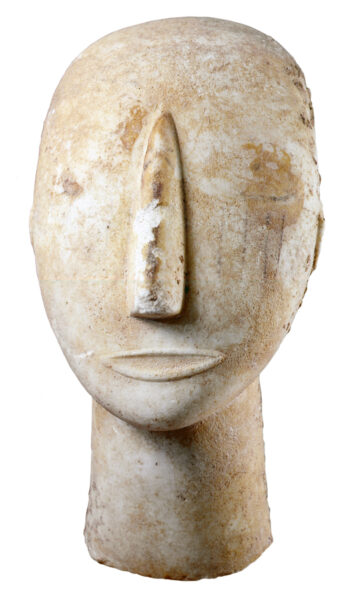Exhibit of the month
«The marble white face of the Cyclades»
National Archaeological Museum
Collection of Prehistoric Antiquities, inv. no. Π3909
Provenance: Amorgos (bought)
Dimensions: Height: 28 cm.
Date: 2800-2300 B.C. (Early Cycladic ΙΙ period-EC ΙΙ)
Display: Cycladic Antiquities Exhibition, Room 4 (entrance area, Showcase Κ1).
…μακροτέρην καὶ πάσσονα θῆκεν ἰδέσθαι,
λευκοτέρην δ’ ἄρα μιν θῆκε πριστοῦ Ἐλέφαντος
(Homer, Odyssey, rhapsody σ 195–6).
and she made her taller, too, and statelier to behold,
and made her whiter than new-sawn ivory.
(Homer, Odyssey, rhapsody σ 195–6)
A most probably female figure, carved in bright white Cycladic marble, does not let us see but its face, as only the head is preserved, broken away from the body that has not been found[1]. Taking a leap of more that one thousand and five hundred years ahead, we come across the text of Homer’s Odyssey, where the rejuvenation of Penelope’s beauty occurs in her sleep, with the divine intervention of Athena. The goddess makes the queen of Ithaca taller, statelier to behold and with skin whiter than new-sawn ivory, as the verses in the opening of the text inform us.
The marble face of the Cyclades, on the basis of its dimensions, belongs to a life-size statue (about 1,50 m. in height) and is classified in the canonical type of marble female figurines of the Early Cycladic II period, namely statuettes and rarely life-size statues[2], of upright, naked, with arms folded under the breasts figures. This type is very widespread in the Cyclades. Although it presents local variations, from one insular unit to the other, the present head recalling rather Naxian creations-, it displays standardized elements, that make it emblematic and culturally unifying, as opposed to the more localized types of the Early Cycladic I period.
Distinct in the iconography of the canonical type, is the marble white face of the Cyclades. Not only it does not lack the beauty ‘presents’ of Athena, tall stature for the time, imposing posture and white skin, but also the Cycladic sculptor had rendered in relief the ears, nose and mouth[3], while painted in black colour[4] are the eyes and under each eye four red vertical lines[5]. The latter have been convincingly interpreted as ‘nail scratches’, out of which blood flows down the face of a mourner[6].
Perhaps, one would not need more ‘portrait’ or ‘psychological’ elements, in order to understand the primordial figure. Yet, it remains enigmatic, without individualized features. Of course, in the perception of the society that created it, it had specific meaning and identity characteristics, unknown to us. Repeating the same leap in time, we see that in Homer beauty, bravery, charm, attraction, even fear, are not indicated by a single word, but descriptively, being associated with a broader than the individual, idea and concept. A concept that brings to mind a certain known situation, image or event, natural or divine, familiar to all and embedded in the ideology of the society it belongs to. Before we learn more about the Early Cycladic society, we will not be able to understand our marble white face. It will remain a creation of prehistoric art, without an epic poem to enliven it before our eyes. A mourner, a goddess, the soul of the dead, a servant accompanying the dead across the river to the afterlife?
[1] In the Stone Objects Inventory of the Archaeological Society of Athens the head bears the number 4270 and it is mentioned that the Society bought it from Ioannis Palaiologos (antiquarian, antiquities dealer and illegal excavator of the time) and as its provenance the island of Amorgos. No exact date of the transaction is stated, but in all probability took place in the last decades of the 19th century (Ντόρα Βασιλικού 2006, Οι ανασκαφές της Αρχαιολογικής Εταιρείας στις Κυκλάδες, Athens: Archaeological Society of Athens Library, no. 242, pp. 45-46).
[2] The monumental marble figurine/statue (NAM inv. no. Π 3978) in the Stone Objects Inventory of the Archaeological Society of Athens bears the number 4223, where it is mentioned that it comes from Amorgos, that it “was bought from Ioannis Palaiologos” and that it “was found in the grave deliberately broken, as the seller [Ioannis Palaiologos] says who excavated it, in order to fit in it, since the length and width of the pit was smaller that the total length of the statue”.
[3] Rendering in relief of face features, especially of the mouth, is rather rarely seen on Early Cycladic figurines.
[4] In the bibliography known is the use of colours on the head of Early Cycladic II figurines, especially for the rendering of face features and the hair.
[5] In the context of the research project ‘The Technology of Early Cycladic Marble’ (2016-2019) financed by INSTAP, under the auspices of the National Archaeological Museum and the Museum of Cycladic Art, in collaboration with DEMOCRITOS (Dr Andreas Karydas, NIMP Research Director), the presence of red colour (mercuric sulphide-cinnabar) was traced on the vertical lines. The similarly as the research project titled volume is under final preparation (Katia Manteli and Nikos Papadimitriou, editors).
[6] Quite a few of the Early Cycladic marble anthropomorphic figurines have been found in graves, as attested in the bibliography.
Katia Manteli
Dr Archaeologist
BIBLIOGRAPHY
Hoffman, G.L. 2002. “Painted Ladies: Early Cycladic II Mourning Figures?”, American Journal of Archaeology, vol. 106, no. 4, pp. 525-550.
Σταμπολίδης, Ν. Χρ. and Σωτηρακοπούλου, Π., 2007. Αιγαίου Κύματα. Έργα του Πρωτοκυκλαδικού Πολιτισμού στο Μουσείο Κυκλαδικής Τέχνης. Athens: Nikolaos P. Goulandris Foundation. Museum of Cycladic Art.
Birtacha, K. 2016, “Examining the paint on Cycladic figurines”, in M. Marthari, C. Renfrew and M. Boyd (eds) Early Cycladic Sculpture in Context. Oxford: Oxbow Books, pp. 491-502.
Shakeshaft, H. 2019. “The terminology for Beauty in the Iliad and the Odyssey”, The Classical Quarterly, vol. 69, no.1, pp. 1-22.


